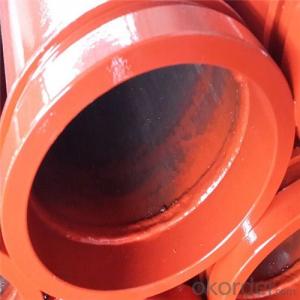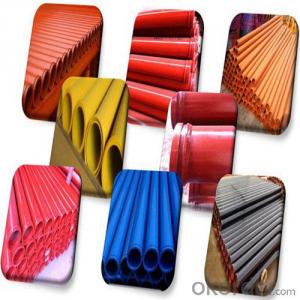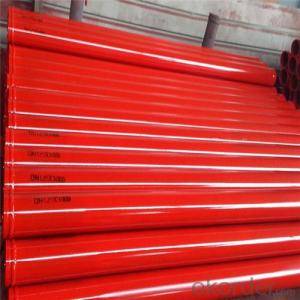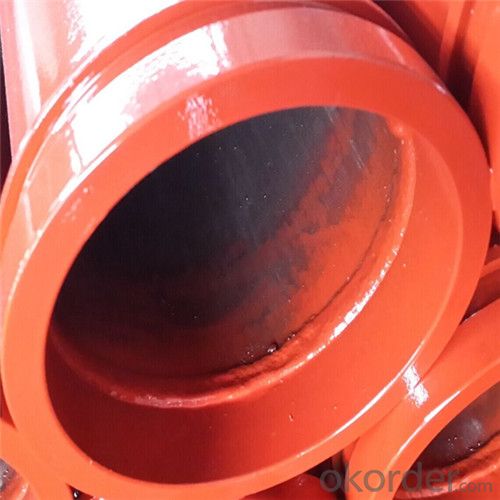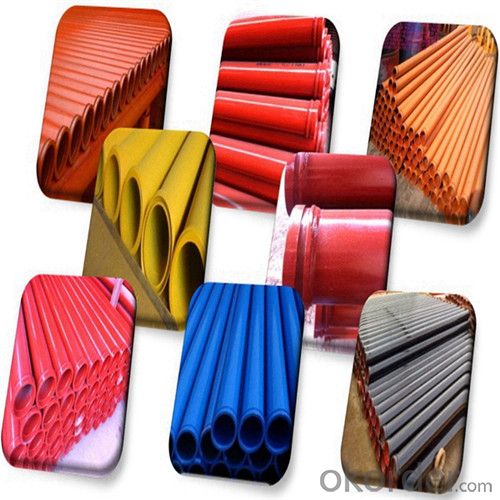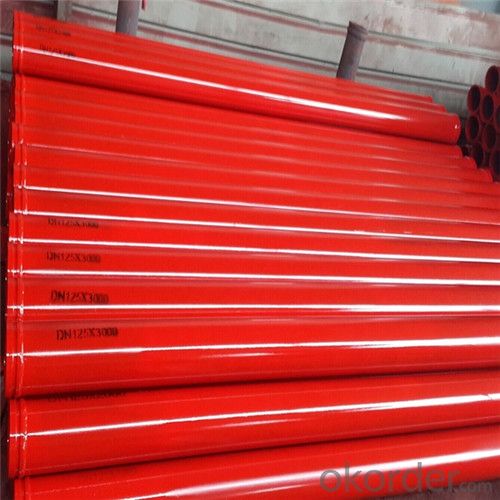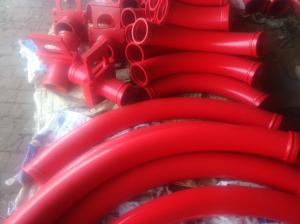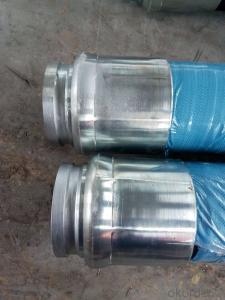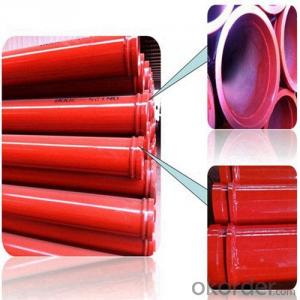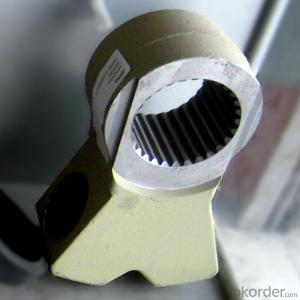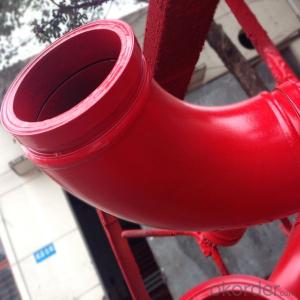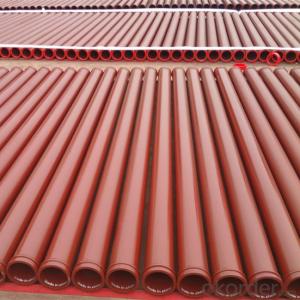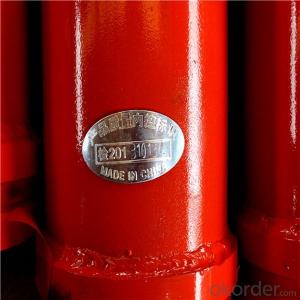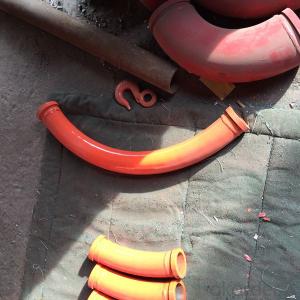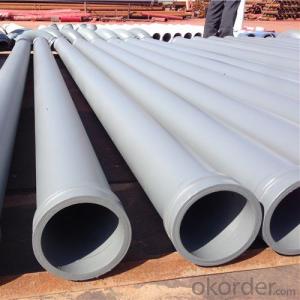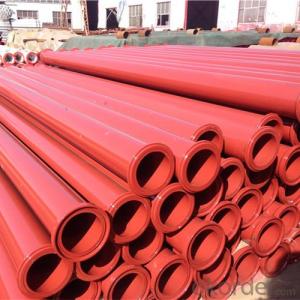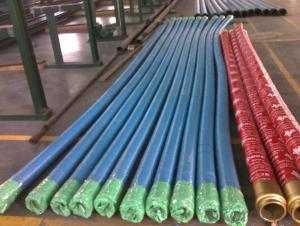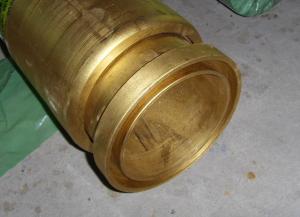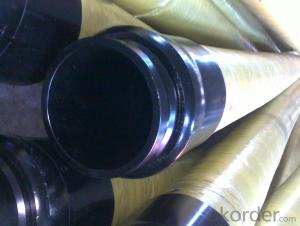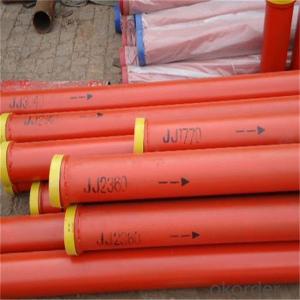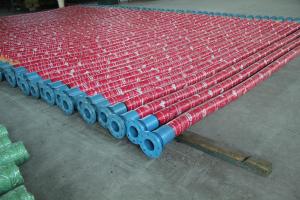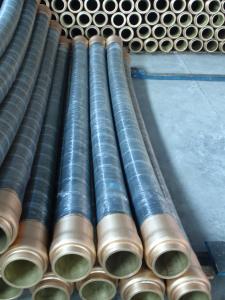3M Concrete Pump St52 Seamless Delivery Pipe
- Loading Port:
- Tianjin
- Payment Terms:
- TT or LC
- Min Order Qty:
- 50 pc
- Supply Capability:
- 5000 pc/month
OKorder Service Pledge
OKorder Financial Service
You Might Also Like
3M Concrete Pump St52 Seamless Delivery Pipe
1. Structure of 3M Concrete Pump St52 Seamless Delivery Pipe:
St52 Weld Pipe: Main use for Trailer-mounted pump, thickness has 4.0mm, 4.5mm, 5mm. Compare with for Truck-mounted pump. Weld pipe has cheaper price, so it is popular in Saudi, Pakistan, India, etc. Unit Price is about 30USD-33USD.
St52 Seamless Pipe: Now More People like use this kind for Truck Pump and Trailer Pump because of the quality is better and it is seamless kind, so this kind pipe is most popular in Middle East Price About 34USD-37USD.
Wear Resistant Pipe: Use for Truck Pump, Wear Resistant Layer is 2.5mm.Through heat treatment way make this pipe more strong (HRC60-62), Using Life: 25,000m³-35,000m³ Price about 65USD-68USD.
2. Main Features of 3M Concrete Pump St52 Seamless Delivery Pipe:
• In case of quality problem the company provide free replacement.
• Provide technical support for free.
• Provide consumers with regular visits
• Ensure the supply of ancillary parts
• Our company passed the ISO9000 certification, the product through 3C certification in full compliance with national standards
3. 3M Concrete Pump St52 Seamless Delivery Pipe Images
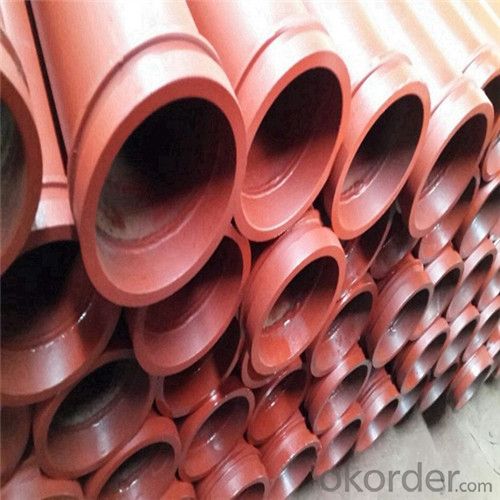
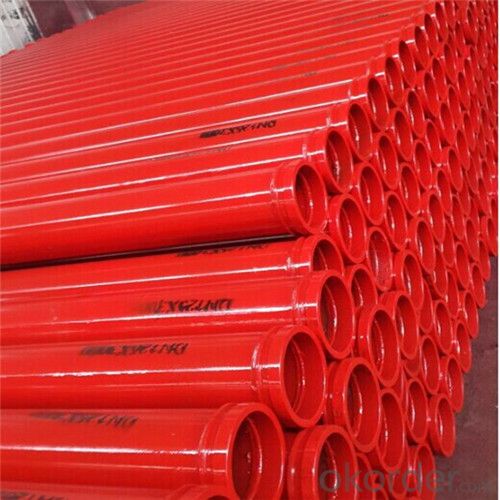
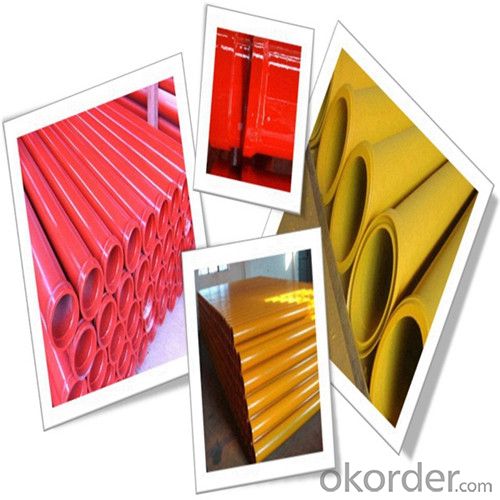
4. 3M Concrete Pump St52 Seamless Delivery Pipe Specification
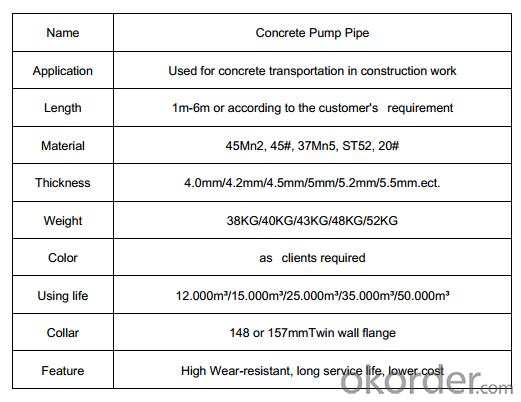
Production Process

5. FAQ
We have organized several common questions for our clients, may help you sincerely:
①Is your products exported a lot?
We have exported to many, many countries. Every year we ship more than 30 containers of these spare parts. Our main market is in Middle-east, Asia & Africa.
②How to guarantee the quality of the products?
We have established the international advanced quality management system,every link from raw material to final product we have strict quality test;We resolutely put an end to unqualified products flowing into the market. At the same time, we will provide necessary follow-up service assurance.
③How long can we receive the product after purchase?
In the purchase of product within three working days, we will arrange the factory delivery as soon as possible. The specific time of receiving is related to the state and position of customers. Commonly 15 working days can be served.
6. Why choose us
• We are a comprehensive manufacturing and trading company.
• Our company is one of the biggest manufacturing and trading companies in China.
• We have been specialized in producing concrete pump spare parts and specialized in producing all kinds of concrete pump parts. As Concrete Pump Pipe, Concrete Pump Elbow, Concrete Pump Rubber Hose, Concrete Pump Wear Plate, Concrete Pump S Valve, Concrete Pump Piston and so on.
• We are famous for our superior quality, competitive prices, first-class craftworks, safe package and prompt delivery.
• We have been supplying concrete pump parts for SCHWING, PUTZMEISTER, SANY, CIFA, KYOKUTO, ZOOMLION for 10 years, so we can promise you the quality and best price.
- Q: How does a concrete pump agitator motor prevent concrete from settling?
- Constantly agitating the mixture, a concrete pump agitator motor prevents the settling of concrete. Typically equipped with rotating paddles or blades inside the mixing drum, the motor ensures that the concrete remains in a homogeneous state. During transportation, concrete tends to separate as gravity and the natural settling of heavier aggregates take effect. This can lead to a non-uniform consistency, with denser materials sinking and water rising. To counteract this settling process, the agitator motor stirs the concrete continuously. By creating a turbulent flow within the mixing drum, the rotating paddles or blades prevent the heavier aggregates from settling, thus maintaining a consistent mixture. This agitation helps distribute the cement, aggregates, water, and any additional additives evenly throughout the concrete, resulting in a more reliable and uniform end product. By preventing concrete settling, the agitator motor ensures that the mixture remains consistently workable, free from blockages or inconsistencies, and suitable for pumping or pouring. This is particularly crucial in construction projects that require precise and consistent concrete placement. In conclusion, the agitator motor in a concrete pump prevents settling by continuously agitating the mixture, thus maintaining its homogeneity and ensuring a consistent flow during pumping or pouring operations.
- Q: Are there any specific brands or manufacturers that are recommended for concrete pump spare parts?
- Yes, there are several brands and manufacturers that are highly recommended for concrete pump spare parts. Some of the top brands in the industry include Putzmeister, Schwing, Sany, and Zoomlion. These brands are known for their high-quality products, reliability, and durability. They have a wide range of spare parts available for various models of concrete pumps, ensuring that customers can find the specific parts they need. Additionally, these brands have established a strong reputation in the market and have a vast network of dealers and distributors worldwide, making it easier for customers to access their spare parts. It is always advisable to choose spare parts from reputable brands and manufacturers to ensure the longevity and performance of your concrete pump.
- Q: How does a hopper agitator motor ensure consistent concrete mixing?
- A hopper agitator motor ensures consistent concrete mixing by providing the necessary agitation and movement within the hopper. The motor is designed to rotate and move the agitator blades, which helps in effectively mixing the concrete ingredients. The primary function of the hopper agitator motor is to prevent the concrete from settling or segregating during the mixing process. As the motor rotates, it creates a swirling motion inside the hopper, ensuring that all the ingredients are evenly distributed and thoroughly mixed. This prevents any clumps or inconsistencies in the final concrete mixture. Additionally, the motor also helps in breaking up any lumps or clusters that may have formed within the hopper. This action further enhances the uniformity of the mixture and ensures that all the components, such as cement, aggregates, water, and additives, are properly blended together. Furthermore, the continuous movement of the agitator blades also helps in maintaining the desired consistency and homogeneity of the concrete mix. It prevents the heavier particles from settling at the bottom of the hopper, ensuring that the mixture remains consistent throughout the entire mixing process. Overall, the hopper agitator motor plays a crucial role in ensuring consistent concrete mixing by providing the necessary agitation, preventing segregation, breaking up lumps, and maintaining uniformity. Its rotational motion and strategically designed agitator blades help in achieving a well-mixed and homogeneous concrete mixture, which is essential for producing high-quality and durable concrete structures.
- Q: What are the performance characteristics of concrete pump?
- Wear resistant alloy glasses plate and floating cutting ring, long service life
- Q: Are there any specific guidelines for the disposal of hydraulic fluids used in concrete pump spare parts?
- Concrete pump spare parts require specific guidelines for disposing of the hydraulic fluids they use. Hydraulic fluids contain chemicals and contaminants that can harm the environment if not disposed of correctly. Here are some general guidelines to follow: 1. Research local regulations: Different regions have specific laws and regulations for disposing of hydraulic fluids. It's important to familiarize yourself with these rules to make sure you comply. 2. Prevent leaks: Properly contain the hydraulic fluid to avoid leaks or spills during transportation. Use containers designed for hazardous materials. 3. Avoid mixing fluids: Don't mix hydraulic fluids with other substances as it can complicate disposal and increase environmental damage. 4. Find a licensed disposal facility: Locate a licensed facility that handles hazardous waste disposal. These facilities have the equipment and expertise to handle hydraulic fluids safely. 5. Follow instructions: When delivering the hydraulic fluid to the disposal facility, follow their specific drop-off instructions. They may require specific labeling or documentation for proper handling. 6. Consider recycling options: Depending on the type of hydraulic fluid, recycling might be an option. Some facilities specialize in recycling hydraulic fluids, which is more environmentally friendly. 7. Educate staff: Make sure all personnel working with hydraulic fluids understand proper disposal procedures and their importance. By following these guidelines, you can safely and responsibly dispose of hydraulic fluids used in concrete pump spare parts, minimizing environmental harm and complying with regulations.
- Q: What are the indications of a malfunctioning concrete pump water pump?
- Some indications of a malfunctioning concrete pump water pump may include decreased water flow, unusual noises or vibrations coming from the pump, leaks or water pooling around the pump, and inconsistent or insufficient water pressure.
- Q: How often should concrete pump remote controls be inspected and maintained?
- Concrete pump remote controls should be inspected and maintained on a regular basis to ensure their proper functioning and to prevent any potential issues. The frequency of inspections and maintenance will depend on various factors such as the intensity of use, environmental conditions, and the specific recommendations provided by the manufacturer. As a general guideline, it is recommended to inspect and maintain concrete pump remote controls at least once every three months. This includes checking for any visible damage, loose or worn-out parts, and ensuring that all buttons and switches are working properly. Additionally, it is important to inspect and clean the battery compartment, and replace batteries if necessary. However, in high-demand situations or extreme environmental conditions, more frequent inspections and maintenance may be required. For instance, if the concrete pump is used in a harsh environment with excessive dust or moisture, it may be necessary to increase the frequency of inspections and cleanings to prevent any potential damage or malfunction. It is also crucial to follow the manufacturer's guidelines and recommendations for maintenance. They may provide specific instructions on lubrication, calibration, or other maintenance procedures that should be performed at regular intervals. By adhering to these guidelines, concrete pump remote controls can be kept in optimal condition, ensuring safe and efficient operation.
- Q: What are the different types of concrete pump hydraulic filters?
- There are three main types of concrete pump hydraulic filters: suction filters, return line filters, and pressure line filters. Suction filters are located at the inlet of the pump and prevent debris from entering the system. Return line filters clean the hydraulic oil as it returns from the system back to the reservoir. Pressure line filters are installed in the discharge line and remove contaminants before the oil reaches the hydraulic components.
- Q: How is the piping of the concrete pipe designed?
- When pumping underground structures, the horizontal axis of the ground shall be perpendicular to the axis of the Y - shaped discharge port
- Q: How does a concrete pump hopper grate prevent clogs?
- A concrete pump hopper grate prevents clogs by acting as a filtering mechanism. It allows only small-sized aggregates to pass through, while blocking larger debris or chunks from entering the pump system. This ensures a smooth flow of concrete, preventing any obstructions or blockages that could potentially cause damage to the pump or hinder the pumping process.
Send your message to us
3M Concrete Pump St52 Seamless Delivery Pipe
- Loading Port:
- Tianjin
- Payment Terms:
- TT or LC
- Min Order Qty:
- 50 pc
- Supply Capability:
- 5000 pc/month
OKorder Service Pledge
OKorder Financial Service
Similar products
Hot products
Hot Searches
Related keywords
